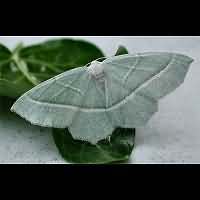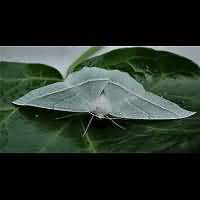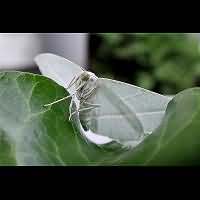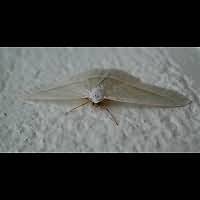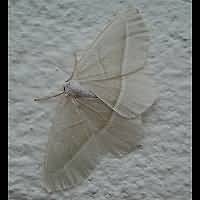Light Emerald (Campaea margaritata)
The Light Emerald belongs to the green Geometers. It is one of the lightest and the green soon fades into white. Identification is made easy by the tip of the wing, which is shaped like a little hook and usually has a small dark spot inside. The Light Emerald also has a broad, almost straight green and white line. The smaller line above is often invisible in white animals. The only moth looking like this one is the Small Emerald, which normally is smaller and darker in colour. It also has the usual rounded wing tips and a line which is white only and rather wavy. The Light Emerald is a rather big Geometer, reaching a wingspan of 42 to 55 mm.
Even though the first eggs are laid in May, it usually takes them to August to hatch. The larvae grow quite fast, but go into hibernation before completing their development. They often overwinter sitting completely visible on top of a twig. A smaller number of larvae hatch immediately after the eggs have been laid and pupate in June to produce a second generation of moths, on the wing in August. The larva is rather unmarked and greyish brown or greenish brown. It is a little hairy near the legs. The caterpillar of the Light Emerald may be some 35 to 40 mm long. It lives on numerous deciduous trees, including oak, hawthorn and birch. The pupa is spun into a cocoon and may be found among the leaflitter. It takes the Light Emerald about one month to pupate.
The species is double-brooded. The first generation flies in May and the beginning of June, the second in August. In small numbers the Light Emerald is seen between the two generations and in September and October. Readily comes to light. A common species all over the British Isles, except if there are no trees. Usually found in forests, parks and large gardens, even in urban surroundings. In Europe a common species all over.
The Light Emerald belongs to the green Geometers. It is one of the lightest and the green soon fades into white. Identification is made easy by the tip of the wing, which is shaped like a little hook and usually has a small dark spot inside. The Light Emerald also has a broad, almost straight green and white line. The smaller line above is often invisible in white animals. The only moth looking like this one is the Small Emerald, which normally is smaller and darker in colour. It also has the usual rounded wing tips and a line which is white only and rather wavy. The Light Emerald is a rather big Geometer, reaching a wingspan of 42 to 55 mm.
Even though the first eggs are laid in May, it usually takes them to August to hatch. The larvae grow quite fast, but go into hibernation before completing their development. They often overwinter sitting completely visible on top of a twig. A smaller number of larvae hatch immediately after the eggs have been laid and pupate in June to produce a second generation of moths, on the wing in August. The larva is rather unmarked and greyish brown or greenish brown. It is a little hairy near the legs. The caterpillar of the Light Emerald may be some 35 to 40 mm long. It lives on numerous deciduous trees, including oak, hawthorn and birch. The pupa is spun into a cocoon and may be found among the leaflitter. It takes the Light Emerald about one month to pupate.
The species is double-brooded. The first generation flies in May and the beginning of June, the second in August. In small numbers the Light Emerald is seen between the two generations and in September and October. Readily comes to light. A common species all over the British Isles, except if there are no trees. Usually found in forests, parks and large gardens, even in urban surroundings. In Europe a common species all over.

